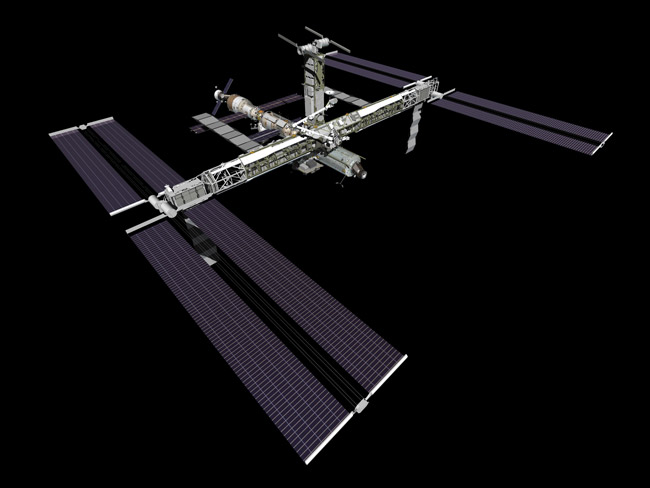Mission Atlantis: New Spacewalking Tools for ISS Construction

When NASAspacewalkers head outside the International Space Station (ISS) next week toinstall new solar arrays and other equipment, they?ll have some newtape-wrapped tools at their disposal.
The fourspacewalkers of NASA?s Atlantis shuttle crew are borrowing techniques andimprovised tools from two earlier ISS-bound shuttle missions, as well as newhardware of their own, to complete the three planned excursions of theirSTS-117 mission.
?Kind ofthe theme that?s running through here is that we get to learn the challengesthat other crews have faced,? STS-117 mission specialist Patrick Forrester, aveteran spacewalker, said in a preflight briefing.
Two newtools will help Forrester and his fellow spacewalkers wrestle tough bolts intosubmission and swap out a station vent. Others will help spacewalkers coax anolder ISS solar array into its storage boxes.
?There?salways usually something new that comes up,? Atlantis astronaut Steve Swanson,who is making his first spaceflight and spacewalk during STS-117, said in apreflight interview. ?I hope I?m trained well enough to handle thosesituations.?
Commandedby veteran shuttle flyer Rick Sturckow, Atlantis? STS-117 mission is set to launch tonight at 7:38 p.m. EDT (2338 GMT) from NASA?s Kennedy Space Center in Cape Canaveral, Florida. The planned 11-day spaceflight will deliver a pair of newstarboard trusses and solar arrays to the ISS and ferry a new crewmember tothe orbital laboratory.
Stickybolts, stubborn arrays
Get the Space.com Newsletter
Breaking space news, the latest updates on rocket launches, skywatching events and more!
Chief amongthe STS-117 spacewalkers? new tools is a device designed to amplify the amountof force an astronaut exerts by 12 times to remove sticky restraint bolts onnew space station segments.
DuringNASA?s STS-115shuttle flight in September 2006 -- which delivered a pair of portsidesolar arrays to the ISS -- spacewalkers struggled to remove vital launchrestraint bolts that, if left in place, would have prevented the new stationpower plants from rotating to track the Sun.
STS-117spacewalkers will tackle a similar set of bolts while installing the station?snew starboard solar arrays during their first two spacewalks, but will have atool known as a ?torque multiplier? to beef up the lock removal task. Thedevice is typically reserved for use on bolts within a space shuttle?s cargobay, but has been adapted to fit ISS hardware, NASA officials said.
?Usingthat, we don?t think that we?ll have any problem pulling any of the launchrestraints off,? Swanson said in NASA interview.
KeithJohnson, NASA?s lead STS-117 spacewalk officer, said the Atlantis astronautswill also rely on improvised tape-wrapped scrapers, pliers and hookedtools.
?to help fold away an older solararray extending starboard from the top of the station?s mast-like Port 6 trussduring their second or third excursion. The tools were first used during December?sSTS-116 mission to free snags and incorrect folds on an earlier Port 6array retraction.
?We haveareas that we may need to poke or may need to get into position,? Johnson said,adding that each of the tools are wrapped in translucent orange Kapton tape toward off electric shocks from the old arrays.
During thethird planned spacewalk of the STS-117 mission, astronauts Jim Reilly and DannyOlivas are expected to install a new hydrogen vent valve to the exterior of thespace station?s NASA Destiny laboratory that will allow the future activationof a U.S. oxygen generator to support larger outpost crews. But to do that,engineers had to come up with a new piece of hardware.
?Theproblem is that we don?t have any standard tools to do that kind of remove andreplace,? Johnson said.
To installthe new hydrogen vent, engineers came up with a ?fluid fitting torque device?that is designed to fit around the vent?s attachment point, drive loose aconnecting bolt and free the spot for the new hardware.
?It?s veryheavy,? Johnson said of the new tool. ?It?s kind of like a boat anchor as faras I?m concerned.?
Altogether,the improvised and new tools in the STS-117 crew?s spacewalking arsenal shouldclear the way for the station?s new starboard solar arrays and bring theorbital laboratory one step closer to completion, mission managers said.
?Now,you?ll see the symmetry,? Johnson said of the space station?s configurationonce the three STS-117 spacewalks are complete. ?[The] space station isstarting to look like what we want it to look like.?
- SPACE.com Video Interplayer: Space Station Power Up with STS-117
- STS-117 Power Play: Atlantis Shuttle Crew to Deliver ISS Solar Wings
- Complete Shuttle Mission Coverage
- All About the Space Shuttle
Join our Space Forums to keep talking space on the latest missions, night sky and more! And if you have a news tip, correction or comment, let us know at: community@space.com.

Tariq is the Editor-in-Chief of Space.com and joined the team in 2001, first as an intern and staff writer, and later as an editor. He covers human spaceflight, exploration and space science, as well as skywatching and entertainment. He became Space.com's Managing Editor in 2009 and Editor-in-Chief in 2019. Before joining Space.com, Tariq was a staff reporter for The Los Angeles Times covering education and city beats in La Habra, Fullerton and Huntington Beach. In October 2022, Tariq received the Harry Kolcum Award for excellence in space reporting from the National Space Club Florida Committee. He is also an Eagle Scout (yes, he has the Space Exploration merit badge) and went to Space Camp four times as a kid and a fifth time as an adult. He has journalism degrees from the University of Southern California and New York University. You can find Tariq at Space.com and as the co-host to the This Week In Space podcast with space historian Rod Pyle on the TWiT network. To see his latest project, you can follow Tariq on Twitter @tariqjmalik.









